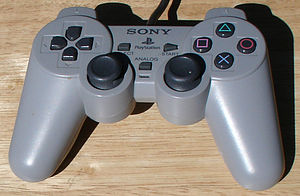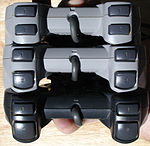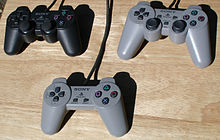- Dual Analog Controller
-
This article is about the Sony controller. For the dual analog control scheme, see Analog stick#Dual analog sticks.
Dual Analog 
The Dual Analog ControllerManufacturer Sony Computer Entertainment Generation Fifth generation era Retail availability April 25, 1997 Discontinued Mid-1998 Connectivity PlayStation Port The PlayStation Dual Analog Controller (SCPH-1150 in Japan, SCPH-1180 in the United States and SCPH-1180e in Europe) was Sony's first attempt at a handheld analog controller for the PlayStation, and the predecessor to the DualShock. Their first official analog controller was the PlayStation Analog Joystick (SCPH-1110).
Contents
History
The Dual Analog Controller was first displayed under glass at the PlayStation Expo 96-97 which was held from November 1 to November 4, 1996. It was released in Japan in April 1997, coincident with the Japanese releases of analog-capable titles Tobal 2 and Bushido Blade.[1] It was advertised as allowing for more precise and fluid control of the games' fighters, with the rumble feature contributing to a more realistic experience.[citation needed]
Before its release in the United States, Sony decided that vibration feedback would be removed from the European and American versions of the controller. According to a Sony spokeperson, "We evaluated all the features and decided, for manufacturing reasons, that what was most important to gamers was the analog feature."[2]
It was released in the United States on August 27, 1997; and in Europe in later 1997 with little promotion. A few months later, the first DualShock controller was released in Japan on November 20, 1997.
Namco had already released an analog controller for PlayStation called NeGcon. Sony's Dual Analog Controller's analog mode was not compatible with the NeGcon-compatible games such as Wipeout and Ridge Racer. However, Need for Speed II, Gran Turismo, and Gran Turismo 2 feature compatibility with both NeGcon and Dual Analog control schemes.
Fans of a smaller form factor, Japanese gamers complained that the very long hand grips made the controller too large to be held properly and the lack of a rumble feature in the U.S. and European models are the most commonly cited reasons that Sony decided to end production of this controller and redesign it. This redesign eventually became the DualShock.[citation needed]
The Dual Analog controller was discontinued in all three markets in 1998 to be replaced by the DualShock, although some gamers still regard it as the better controller, mostly due to its longer hand grips and ridged shoulder buttons. Furthermore, its rarity has made it highly sought after among collectors.
Features
If a game was compatible with the Dual Analog controller, the player would be able to press the "Analog" button located between the two analog sticks to activate the analog mode. This was indicated by a red LED. If a game was not analog-compatible, and was switched to analog mode, it simply wouldn't register any button presses or, in some cases, the PlayStation would consider the controller to be detached.
The ability to emulate Sony's own FlightStick by pressing the "Analog" button a second time to reveal a green LED (this was commonly referred to as "flightstick mode") provided a less expensive alternative to the FlightStick Analog Joystick and retailed for an average of $35 compared to the Flightstick's retail price of $70.
MechWarrior 2, Ace Combat 2, Descent Maximum, and Colony Wars were among the short list of flightstick compatible games.
Differences from DualShock
The Dual Analog controller features several aspects that remain exclusive to it, and were scrapped or redesigned for the release of the DualShock controller.
- Only the Japanese version features a vibration feedback function. However, the rumble motor in the Japanese version was unstable and could cause damage to the PlayStation itself.[citation needed] The European and American versions of the controller does however include circuitry and mounts for a rumble motor, a possible leftover from the Japanese version of the controller, and therefore installing the motor is a simple process. Due to a lack of vibration-compatible games at the time, the European and American versions were not shipped with rumble feedback and, as a result, weigh significantly less than their overseas counterpart, and fall somewhere between the weights of the standard controller and the DualShock.
- The Japanese version was available in both grey and black, while the European and American versions were only available in grey.
- The hand grips are 1.5 cm longer than the original controller and the later DualShock controller. The body of the controller is also wider, spacing the pads slightly farther apart. This wider controller body has been retained on the DualShock and all later PlayStation controllers.
 From the top: the original PlayStation Controller, Dual Analog Controller and DualShock. Note the ridges on the Dual Analog L2 and R2 buttons.
From the top: the original PlayStation Controller, Dual Analog Controller and DualShock. Note the ridges on the Dual Analog L2 and R2 buttons.
- The L2 and R2 buttons have ridges at the top edge to easily distinguish them from the L1 and R1 buttons and are spaced farther apart than the original controller or DualShock.
- The L2 and R2 buttons are also wider than the standard controller but shorter than the DualShock.
- The analog sticks are concave and lack the rubberised coating that has been used on the Dual Shock and later controllers.
- In addition to the standard digital mode and the regular "red LED" Analog mode, there is a third mode that emulates the layout of Sony's own PlayStation Analog Joystick, and is indicated by a green LED. This feature is missing on the DualShock.
- The "Analog" button, used for switching modes, is raised instead of recessed like the DualShock's button and can be more easily hit accidentally.
- The Analog mode cannot be changed or locked by software as it can with the DualShock controller and later.
- The Dual Analog's rumble circuit will not respond to PlayStation 2 software even if a rumble motor is installed.
References
- ^ IGN staff (April 3, 1997). "Analog Joypad To Go On Sale In Japan". IGN.com. http://psx.ign.com/articles/062/062422p1.html. Retrieved 2008-07-04.
- ^ "PlayStation's Missing Thunder". Next Generation: pp. 26. September.
External links
- "Was this long-lost relative of the Dual Shock a better controller?" by The Next Level.
- ncsx.com product page
- Review by vidgames.com
PlayStation Home consoles Handhelds Games RetailPlayStation games · PlayStation 2 games · PlayStation 3 games (PlayStation Move games · 3D games) · PlayStation Portable games · PlayStation Vita gamesDownloadablePS3 games · PSP games · PSP demos · Minis · PSone Classics (A–M · N–Z · Japan · North America · PAL region) · TurboGrafx-16 games · Neo Geo games · Dreamcast games · PlayStation Suite gamesRe-releasesNetwork PSP-onlyAdhoc Party for PlayStation Portable · Room for PlayStation PortableOthersControllers First-partyPlayStation Controller · PlayStation Mouse · Analog Joystick · Dual Analog · DualShock · Sixaxis · PlayStation MoveThird-partyCameras Kits System software Media MagazinesPlayStation: The Official Magazine · PlayStation Official Magazine (UK) · Official PlayStation Magazine (Australia)CharactersKevin Butler · Marcus Rivers · ToroCompanies Sony Computer Entertainment · Sony Computer Entertainment Worldwide Studios · Sony Online Entertainment · Sony Pictures LootPeople Categories:- Game controllers
- PlayStation 1 peripherals
Wikimedia Foundation. 2010.

